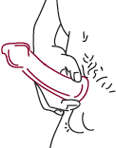
Keep condoms handy. Have some near where you usually have sex. Store them in a cool place where heat won’t damage them. Avoid exposure to extreme low or high temperatures, moisture, direct sunlight and fluorescent light. If the condom is sticky or brittle or looks damaged, do not use it.
Check the date. Condom packages have an expiration date printed on them. Check the date before you unwrap the condom.
Lubrication. If you want extra lubrication to reduce friction during sex, you can spread a water-based lubricant such as K-Y jelly or Astroglide on the condom once it is on the penis.
No oil-based lubricants! Vaseline, lotions, mineral oil, vegetable oil, or cold cream can damage the latex and cause the condom to break. Never use an oil-based product for lubrication with a condom.
Experiment. All condoms are not created equal. Different styles work better for different people.Try several kinds to find a type or brand you like. Be sure to choose a condom that protects against STDs! For example, lambskin condoms only protect against pregnancy; they do not protect against STDs. This information will be printed on the package.
The 3 C’s of Condom Use
- Consistently — Use condoms every time you engage in sexual activity.
- Correctly — Use condoms correctly to avoid pregnancy and transmission of STDs.
- Carefully — Do not tear or damage condoms or let semen spill after use.
Condoms, when used consistently, correctly, & carefully are 97% effective.
Although no prophylactic or contraceptive can guarantee 100% effectiveness, latex condoms, if properly used, will help lower the risk of pregnancy and reduce the risk of transmission of HIV infection (AIDS), hepatitis and other STDs.
However, condoms do not provide full protection against STDs, including Herpes and HPV, that have infected areas that are not covered by the condom (e.g. inner thigh, scrotum, etc). Therefore, communicating with your sexual partner regarding prior sexual history is important!
How to Use a Condom
 | 1. Before Sex
|
2. Putting the Condom On
|  |
 | 3. Roll the Condom Down
|
4. After Sex
|  |
 | 5. Taking the Condom Off
|
Practice makes perfect. Practice putting a condom on by yourself, before you’re with a partner.
Then you’ll be sure you know how! Knowing how to use condoms correctly can help you feel more comfortable and knowledgeable about sex. You can relax and enjoy sex more when you know you’re helping to protect yourself from pregnancy and STDs.
Condom Choices
Lubricated Condoms
- Extra Strength: A stronger condom lubricated with SK-70, but no spermicide.
- Lubricated: A condom with Nonoxynol-9 as a spermicide and lubricant.
- Snugger Fit: Shaped and tailored for closer contact and tighter fit! Lubricated with SK-70, but no spermicide.
- Ribbed: A textured condom for extra sensation! Lubricated with SK-70, but no spermicide.
- Rough Rider: A lubricated condom, “studded” for extra excitement! No spermicide.
Condoms with Spermicide
- Extra Strength: A stronger condom with Nonoxynol-9 as a spermicide and lubricant.
- Lubricated: A condom with Nonoxynol-9 as a spermicide and lubricant.
- Assorted Colors: Assorted colors for variety and fun! With Nonoxynol-9 as a spemicide & lubricant.
Non Lubricated Condoms
- Non Lubricated: A dry condom. No spermicide or lubricant.
- Kiss of Mint: A dry condom that is mint flavored especially for oral sex! No spermicide or lubricant.
What is SK-70?
SK-70 is a silicon LUBRICANT, often used with condoms. It does not contain a spermicide.
What is Nonoxynol-9?
Nonoxynol-9 is a SPERMICIDE, used with some condoms. It also serves as a lubricant.
What is Spermicide?
Spermicide is a chemical product that kills sperm. This chemical may also kill some STD causing organisms. “STD” means sexually transmitted disease.
Allergies
Most condoms are made from latex, and many condoms contain a spermicide. An allergy to latex or spermicides can cause redness, burning, and/or itching in the genital area of either partner.
If you experience these symptoms from a latex condom without spermicide, switch to a nonlatex condom.
If you experience these symptoms from a latex condom with a spermicide, switch to a latex condom without a spermicide. If the symptoms return, then switch to a non-latex condom.
No comments:
Post a Comment